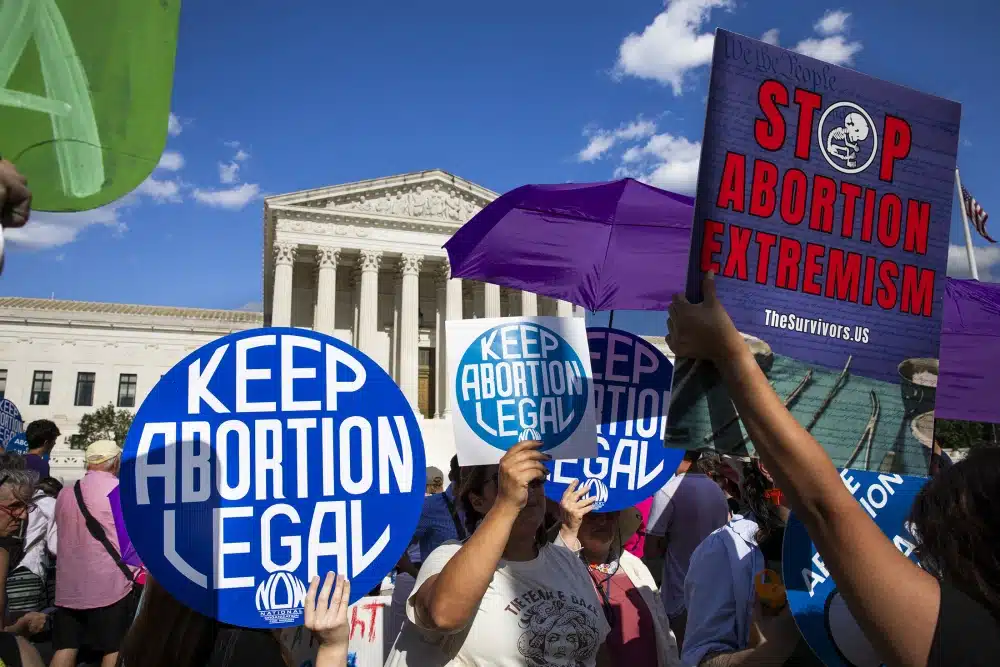After months of collecting signatures, filing petitions, and navigating courts, constitutional amendments to safeguard or extend abortion rights are set to appear on the general election ballots in ten states.
Voters in swing states (Arizona and Nevada), blue-leaning states (Colorado, Maryland, and New York), and red-leaning states (Florida, Missouri, Montana, Nebraska, and South Dakota) will be able to personally decide the future of abortion access this fall. Only Arkansas organisers gathered enough signatures to qualify an abortion rights amendment for the ballot this year.
Since the Supreme Court’s overturning of Roe v. Wade in 2022, these ten efforts will be the most recent attempts to include abortion access in state constitutions.
Here’s what the proposed amendments would do if they passed, as well as how they’d affect the states’ current abortion care legislation.
Arizona
The proposed constitutional amendment on the ballot in this critical southwestern battleground would create a “fundamental right” to abortion up until foetal viability, or around the 24th week of pregnancy. After that, the legislation would prohibit the state from regulating abortion in cases when the pregnant person’s health or life is in danger, according to the treating health care expert.
Abortion is lawful in Arizona until the 15th week of pregnancy, with exceptions for life-saving reasons and no exceptions for rape or incest. If voters accept the proposed ballot initiative in November, it will effectively end the 15-week prohibition. It requires a simple majority of votes to pass.
Colorado
Colorado’s proposed amendment would explicitly recognise the right to abortion and prohibit discrimination against its exercise.
It also specifically specifies that the government may not limit abortion coverage under health insurance plans, including those for public employees and those subsidised by the government. This legislation would effectively repeal a 1984 statute prohibiting people from using their health insurance to pay for abortion care.
The ballot measure in Colorado, where there are no abortion restrictions and no gestational limits for women seeking abortions, is meant to permanently enshrine those rights, which organisers say is critical to preventing lawmakers from undoing them in the future.
To pass in November, the proposition must receive 55% of voter support, not just a simple majority, according to state law.
Florida
The state’s ballot measure prohibits limits on abortion before foetal viability, with exceptions for “the patient’s health, as determined by the patient’s healthcare provider.”
The proposed amendment would eliminate the state’s six-week abortion restriction, with exceptions for rape, incest, and the woman’s life.
According to Florida law, the proposition needs get 60% of voter approval in November, rather than a simple majority, to pass.
Maryland
Maryland lawmakers, who control the amendment process rather than citizens, voted to place a proposition on the ballot that would include abortion rights in the state constitution.
The proposed phrase would provide the right to “make and effectuate decisions to prevent, continue, or end one’s own pregnancy.”
Abortion is already authorised in the state until foetal viability, with exceptions when the woman’s life or health is endangered or a foetal anomaly is discovered. A simple majority is required for passage.
Missouri
Missouri’s proposed amendment protects abortion rights until foetal viability, with exceptions for the mother’s life and health.
The amendment expressly states that the government “shall not deny or infringe upon a person’s fundamental right to reproductive freedom,” which the amendment defines as all decisions related to reproductive health care, including “birth control,” “abortion care,” and “miscarriage care” — up until foetal viability. The plan also states that any “denial, interference, delay, or restriction” of such care is “invalid.”
After then, the government may control abortion unless a treating health care expert determines that the mother’s “life, physical, or mental health” is at risk.
The amendment allows lawmakers and state officials to restrict abortion rights if it improves or maintains a person’s health, aligns with clinical standards and evidence-based medicine, and does not interfere with their autonomy.
Missouri now has one of the harshest abortion laws in the United States, with exceptions for the mother’s life and medical emergency. If the amendment were to succeed, it would effectively repeal the statute. A simple majority is required for passage.
Montana
Montana’s ballot issue proposes amending the state constitution to grant the right to “make and carry out decisions about one’s own pregnancy, including the right to abortion.” likewise “prohibit the government from denying or burdening the right to abortion before foetal viability,” and it will “prohibit the government from denying or burdening access to an abortion when a treating healthcare professional determines it is medically indicated to protect the pregnant patient’s life or health.”
Enshrining abortion rights in Montana’s constitution would make it more difficult for lawmakers to repeal present protections, as abortion is now lawful up until foetal viability. A simple majority is required for passage.
Nebraska
In Nebraska, two competing constitutional amendments will be on the November ballot.
One ballot initiative, “Protect the Right to Abortion,” would change the state’s constitution to specify that “all persons shall have a fundamental right to abortion until foetal viability, or when needed to protect the life or health of the pregnant patient.”
The other, known as “Protect Women and Children,” prohibits abortions in the second and third trimesters, with the exception of a medical emergency or a pregnancy caused by sexual assault or incest.
Nebraska law now prohibits abortion after 12 weeks of pregnancy, with the exception of rape, incest, and preserving the mother’s life. The pro-abortion rights bill would virtually repeal the law, whilst the other would essentially codify it into the state constitution.
To pass in Nebraska, a ballot proposal must get a majority of the vote and at least 35% of the total votes cast in the election in favour. If both amendments pass, the one that receives the most votes wins.
Nevada
In Nevada, abortion is already permitted until the 24th week of pregnancy.To guarantee abortion rights up to foetal viability, reproductive rights campaigners successfully placed a constitutional amendment on the November ballot.
According to state law, even if the initiative succeeds in November, voters must approve it again in 2026 before the Nevada constitution is formally altered.
New York
The amendment process in New York, like in Maryland, is controlled by lawmakers rather than citizens. State legislators voted to place a referendum on the ballot that would include abortion rights in the state constitution.
The Equal Protection of Law Amendment would safeguard a person’s “pregnancy, pregnancy outcomes, and reproductive healthcare and autonomy” by enshrining rights in the state constitution, without specifically mentioning abortion.
Abortion is lawful in New York up until about the 24th week of pregnancy. Passing the plan, which requires only a simple majority, would effectively constitutionalise those projections.
South Dakota
South Dakota’s proposed constitutional amendment would legalise abortion during the first trimester of pregnancy. It would permit “regulation” of abortion by the state in the second trimester of pregnancy, although such control “must be reasonably related to the physical health of the pregnant woman.”
The amendment would authorise “regulation or prohibition” by the state in the third trimester, unless a physician determines that the care is required to “preserve the life or health” of the woman.
If passed, the amendment will effectively repeal the state’s near-total abortion restriction, which was reinstated when Roe v. Wade was overturned in 2022. The rule, which abortion advocates claim is among the most stringent in the United States, outlaws all abortions except when necessary to save the woman’s life.










